Two-Color Quantum Correlation between Down-Conversion Beams at 1.5 and 3.3 μm from a Singly Resonant Optical Parametric Oscillator
Abstract
1. Introduction
2. Theoretical Analysis
3. Experimental Setup
4. Experimental Results and Discussion
5. Conclusions
Author Contributions
Funding
Conflicts of Interest
References
- Braunstein, S.L.; Loock, P.V. Quantum information with continuous variables. Rev. Mod. Phys. 2005, 77, 513–577. [Google Scholar] [CrossRef]
- Kimble, H.J. The quantum internet. Nature 2008, 453, 1023–1030. [Google Scholar] [CrossRef] [PubMed]
- Brida, G.; Genovese, M.; Berchera, I.R. Experimental realization of sub-shot-noise quantum imaging. Nat. Photon. 2010, 4, 227–230. [Google Scholar] [CrossRef]
- Ladd, T.D.; Jelezko, F.; Laflamme, R.; Nakamura, Y.; Monroe, C.; O’Brien, J.L. Quantum computers. Nature 2010, 464, 45. [Google Scholar] [CrossRef]
- Giovannetti, V.; Lloyd, S.; Maccone, L. Advances in quantum metrology. Nat. Photon. 2011, 96, 222–229. [Google Scholar] [CrossRef]
- Taylor, M.A.; Janousek, J.; Daria, V.; Knittel, J.; Hage, B.; Bachor, H.A.; Bowen, W.P. Biological measurement beyond the quantum limit. Nat. Photon. 2013, 7, 229–233. [Google Scholar] [CrossRef]
- Reynaud, S. Generation of Twin Photon Beams by a Nondegenerate Optical Parametric Oscillator. Europhys. Lett. 1987, 4, 427–432. [Google Scholar] [CrossRef]
- Heidmann, A.; Horowicz, R.J.; Giacobino, E.; Fabre, C. Observation of Quantum Noise Reduction on Twin Laser Beams. Phys. Rev. Lett. 1987, 59, 2555–2557. [Google Scholar] [CrossRef]
- Pan, Q.; Zhang, Y.; Zhang, T.C.; Xie, C.D.; Peng, K.C. Experimental investigation of intensity difference squeezing using Nd: YAP laser as pump source. J. Phys. D Appl. Phys. 1997, 30, 1588–1590. [Google Scholar] [CrossRef]
- Laurat, J.; Longchambon, L.; Fabre, C. Experimental investigation of amplitude and phase quantum correlations in a type II optical parametric oscillator above threshold: From nondegenerate to degenerate operation. Opt. Lett. 2005, 30, 1177–1179. [Google Scholar] [CrossRef][Green Version]
- Takata, K.; Marandi, A.; Yamamoto, Y. Quantum correlation in degenerate optical parametric oscillators with mutual injections. Phys. Rev. A 2015, 92, 043821. [Google Scholar] [CrossRef]
- Li, J.Y.; Olsen, M.K. Quantum correlations across two octaves from combined up- and down-conversion. Phys. Rev. A 2018, 97, 043856. [Google Scholar] [CrossRef]
- Villar, A.S.; Cruz, L.S.; Cassemiro, K.N.; Martinelli, M.; Nussenzveig, P. Generation of bright two-color continuous variable entanglement. Phys. Rev. Lett. 2005, 95, 243603. [Google Scholar] [CrossRef] [PubMed]
- Cassemiro, K.N.; Villar, A.S.; Martinelli, M.; Nussenzveig, P. The quest for three-color entanglement experimental investigation of new multipartite quantum correlations. Opt. Express 2007, 15, 18236–18246. [Google Scholar] [CrossRef] [PubMed]
- Coelho, A.S.; Barbosa, F.A.S.; Cassemiro, K.N.; Villar, A.S.; Martinelli, M.; Nussenzveig, P. Three-Color Entanglement. Science 2009, 326, 823–826. [Google Scholar] [CrossRef]
- Li, Y.; Guo, X.; Bai, Z.; Liu, C. Generation of two-color continuous variable quantum entanglement at 0.8 and 1.5 μm. Appl. Phys. Lett. 2010, 97, 031107. [Google Scholar] [CrossRef]
- Wang, N.; Du, S.; Li, Y. Compact 6 dB Two-color continuous cariable entangled source based on a single ring optical resonator. Appl. Sci. 2018, 8, 330. [Google Scholar] [CrossRef]
- Lane, A.S.; Reid, M.D.; Walls, D.F. Quantum analysis of intensity fluctuations in the nondegenerate parametric oscillator. Phys. Rev. A 1988, 38, 788–799. [Google Scholar] [CrossRef]
- Ribeiro, P.H.S.; Schwob, C.; Matre, A.; Fabre, C. Sub-shot-noise high-sensitivity spectroscopy with optical parametric oscillator twin beams. Opt. Lett. 1997, 22, 1893–1895. [Google Scholar] [CrossRef]
- Wang, H.; Zhang, Y.; Pan, Q.; Su, H.; Porzio, A.; Xie, C.D.; Peng, K.C. Experimental realization of a quantum measurement for intensity difference fluctuation using a beam splitter. Phys. Rev. Lett. 1999, 82, 1414–1417. [Google Scholar] [CrossRef]
- Vasilyev, M.; Choi, S.K.; Kumar, P.; D’Ariano, M. Tomographic measurement of joint photon statistics of the twin-beam quantum state. Phys. Rev. Lett. 2000, 84, 2354–2357. [Google Scholar] [CrossRef] [PubMed]
- Brambilla, E.; Caspani, L.; Jedrkiewicz, O.; Lugiato, L.A.; Gatti, A. High sensitivity imaging with multi-mode twin beams. Phys. Rev. A 2008, 77, 053807. [Google Scholar] [CrossRef]
- Brida, G.; Genovese, M.; Meda, A.; Berchera, I.R. Experimental quantum imaging exploiting multimode spatial correlation of twin beams. Phys. Rev. A 2011, 83, 033811. [Google Scholar] [CrossRef]
- Eugene, K.; Farid, Y.K.; Maria, V.C. Overcoming inefficient detection in sub-shot-noise absorption measurement and imaging. Opt. Express 2019, 27, 7868–7885. [Google Scholar]
- Li, M.J.; Nolan, D.A. Optical transmission fiber design evolution. J. Lightwave Technol. 2008, 26, 1079–1092. [Google Scholar] [CrossRef]
- Peltola, J.; Vainio, M.; Hieta, T.; Uotila, J.; Sinisalo, S.; Metsälä, M.; Siltanen, M.; Halonen, L. High sensitivity trace gas detection by cantilever-enhanced photoacoustic spectroscopy using a mid-infrared continuous-wave optical parametric oscillator. Opt. Express 2013, 21, 10240–10250. [Google Scholar] [CrossRef]
- Cumis, M.S.; Viciani, S.; Borri, S.; Patimisco, P.; Sampaolo, A.; Scamarcio, G.; Natale, P.D.; D’Amato, F.; Spagnolo, V. Widely-tunable mid-infrared fiber-coupled quartz-enhanced photoacoustic sensor for environmental monitoring. Opt. Express 2014, 22, 28222–28231. [Google Scholar] [CrossRef]
- Cui, Y.; Huang, W.; Wang, Z.; Wang, M.; Zhou, Z.; Li, Z.; Gao, S.; Wang, Y.; Wang, P. 4.3 μm fiber laser in CO2-filled hollow-core silica fibers. Optica 2019, 6, 951–954. [Google Scholar] [CrossRef]
- Agafonov, I.N.; Chekhova, M.V.; Leuchs, G. Two-color bright squeezed vacuum. Phys. Rev. A 2010, 82, 011801. [Google Scholar] [CrossRef]
- Cuozzo, D.; Oppo, G.L. Two-color continuous-variable quantum entanglement in a singly resonant optical parametric oscillator. Phys. Rev. A 2011, 84, 043810. [Google Scholar] [CrossRef]
- Bosenberg, W.R.; Drobshoff, A.; Alexander, J.I. 93% pump depletion, 3.5-W continuous-wave, singly resonant optical parametric oscillator. Opt. Lett. 1996, 21, 1336–1338. [Google Scholar] [CrossRef] [PubMed]
- Vainio, M.; Siltanen, M.; Hieta, T.; Halonen, L. Continuous-wave optical parametric oscillator based on a Bragg grating. Opt. Lett. 2010, 35, 1527–1529. [Google Scholar] [CrossRef] [PubMed]
- Hong, X.P.; Shen, X.L.; Gong, M.L.; Wang, F. Broadly tunable mode-hop-free mid-infrared light source with MgO: PPLN continuous-wave optical parametric oscillator. Opt. Lett. 2012, 23, 4982–4984. [Google Scholar] [CrossRef] [PubMed]
- Wu, H.S.; Wang, P.; Song, J.S.; Ye, J.; Xu, J.M.; Li, X.; Zhou, P. High power tunable mid-infrared optical parametric oscillator enabled by random fiber Laser. Opt. Express 2018, 26, 6446–6455. [Google Scholar] [CrossRef]
- Reynaud, S.; Fabre, C.; Giacobino, E. Quantum fluctuations in a two-mode parametric oscillator. J. Opt. Soc. Am. B 1987, 4, 1520–1524. [Google Scholar] [CrossRef]
- Fabre, C.; Giacobino, E.; Heidmann, A.; Reynaud, S. Noise characteristics of a non-degenerate Optical Parametric Oscillator–Application to quantum noise reduction. J. Phys. Fr. 1989, 50, 1209–1225. [Google Scholar] [CrossRef]
- Black, E.D. An introduction to Pound-Drever-Hall laser frequency stabilization. Am. J. Phys. 2001, 69, 79–87. [Google Scholar] [CrossRef]
- Wan, Z.J.; Feng, J.X.; Li, Y.J.; Zhang, K.S. Comparison of phase quadrature squeezed states generated from degenerate optical parametric amplifiers using PPKTP and PPLN. Opt. Express 2018, 26, 5531–5540. [Google Scholar] [CrossRef]
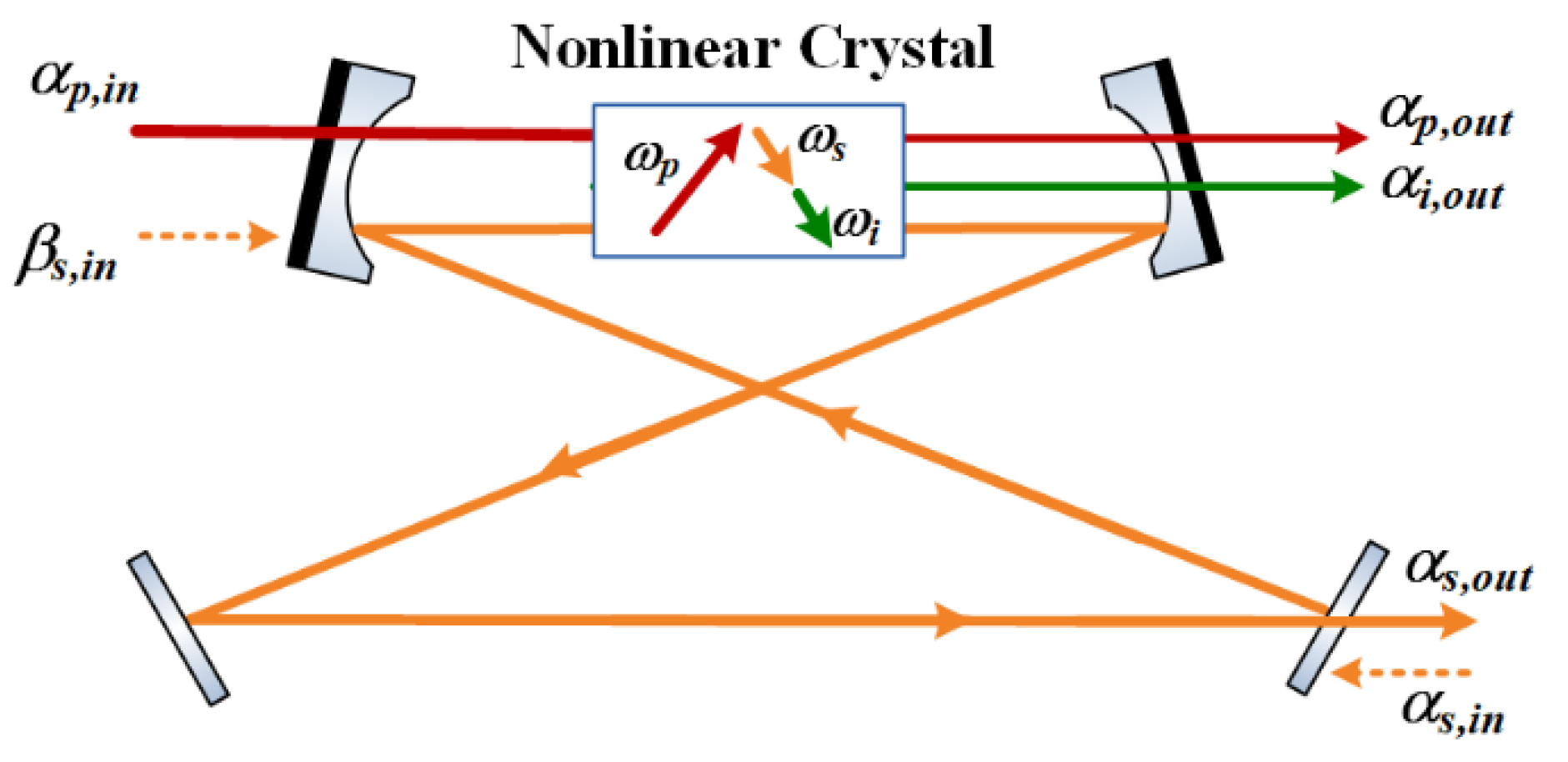
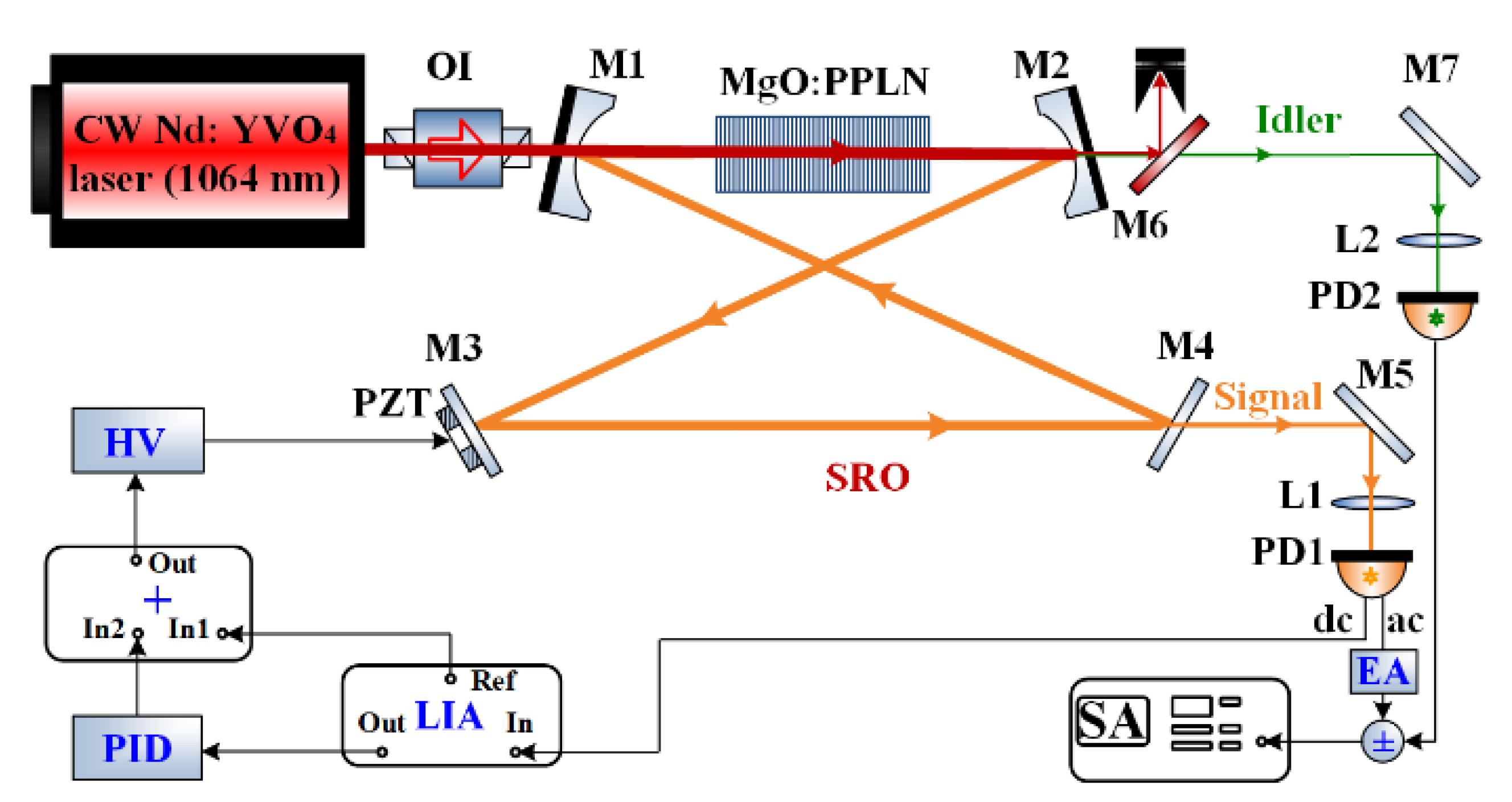
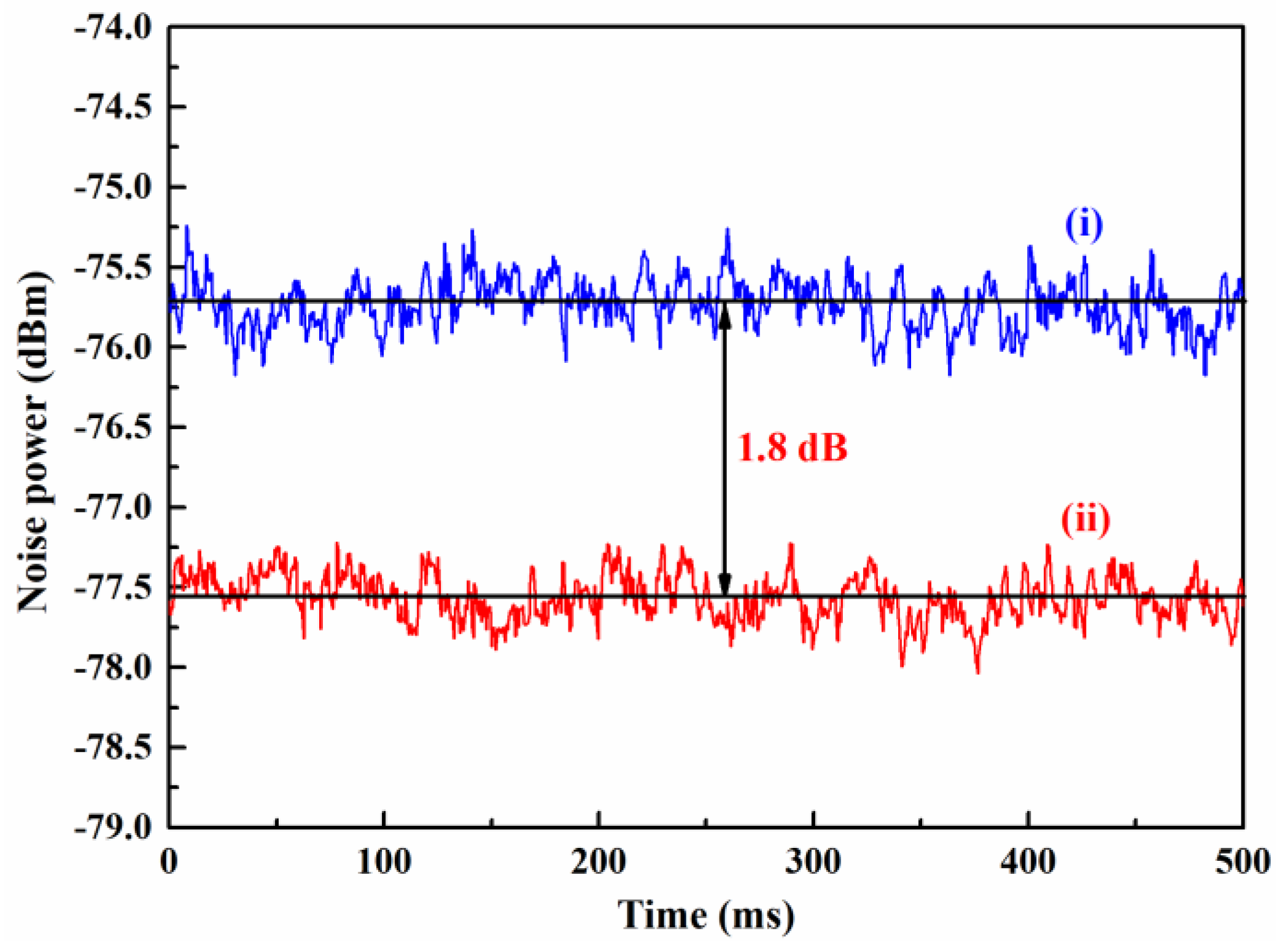
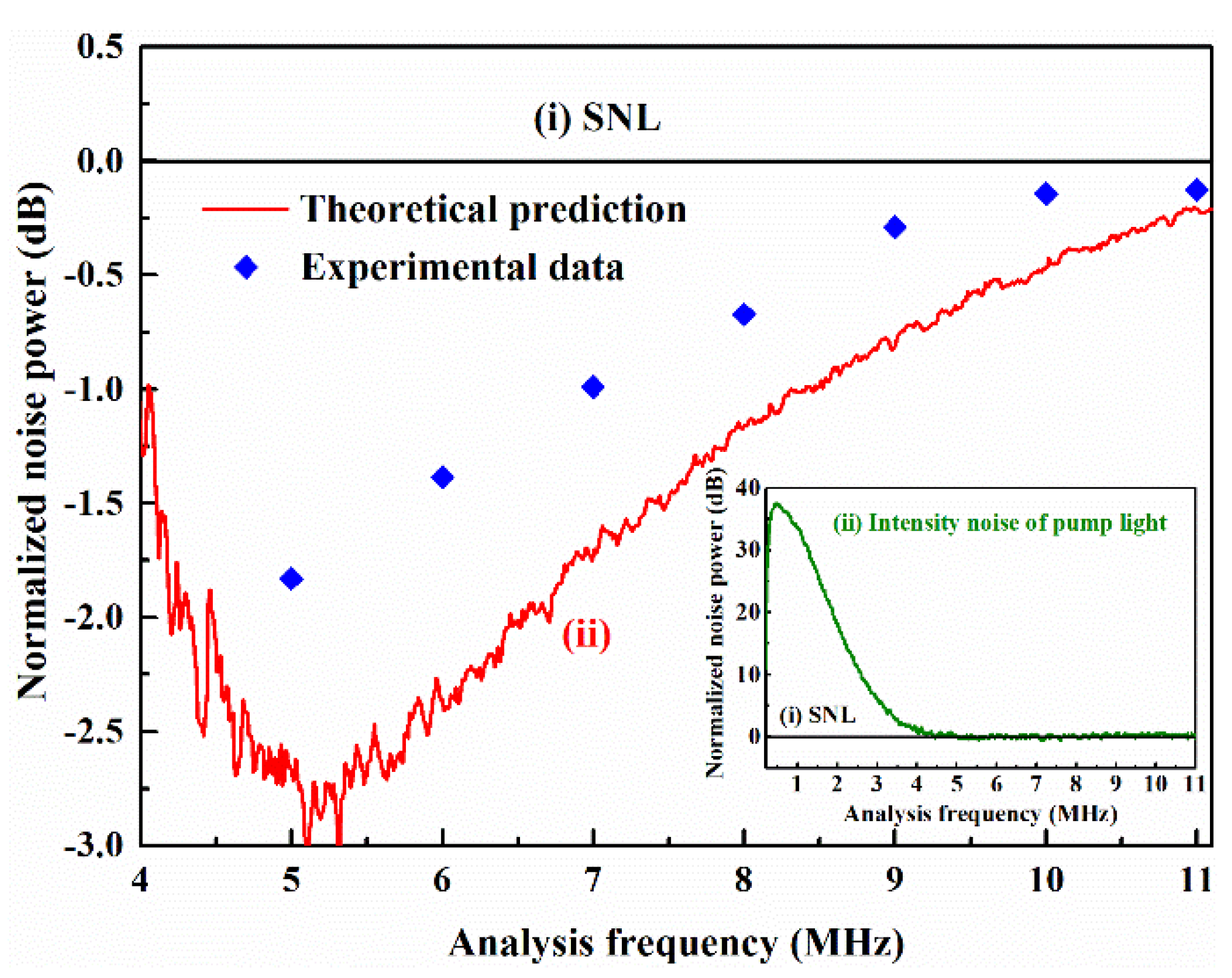
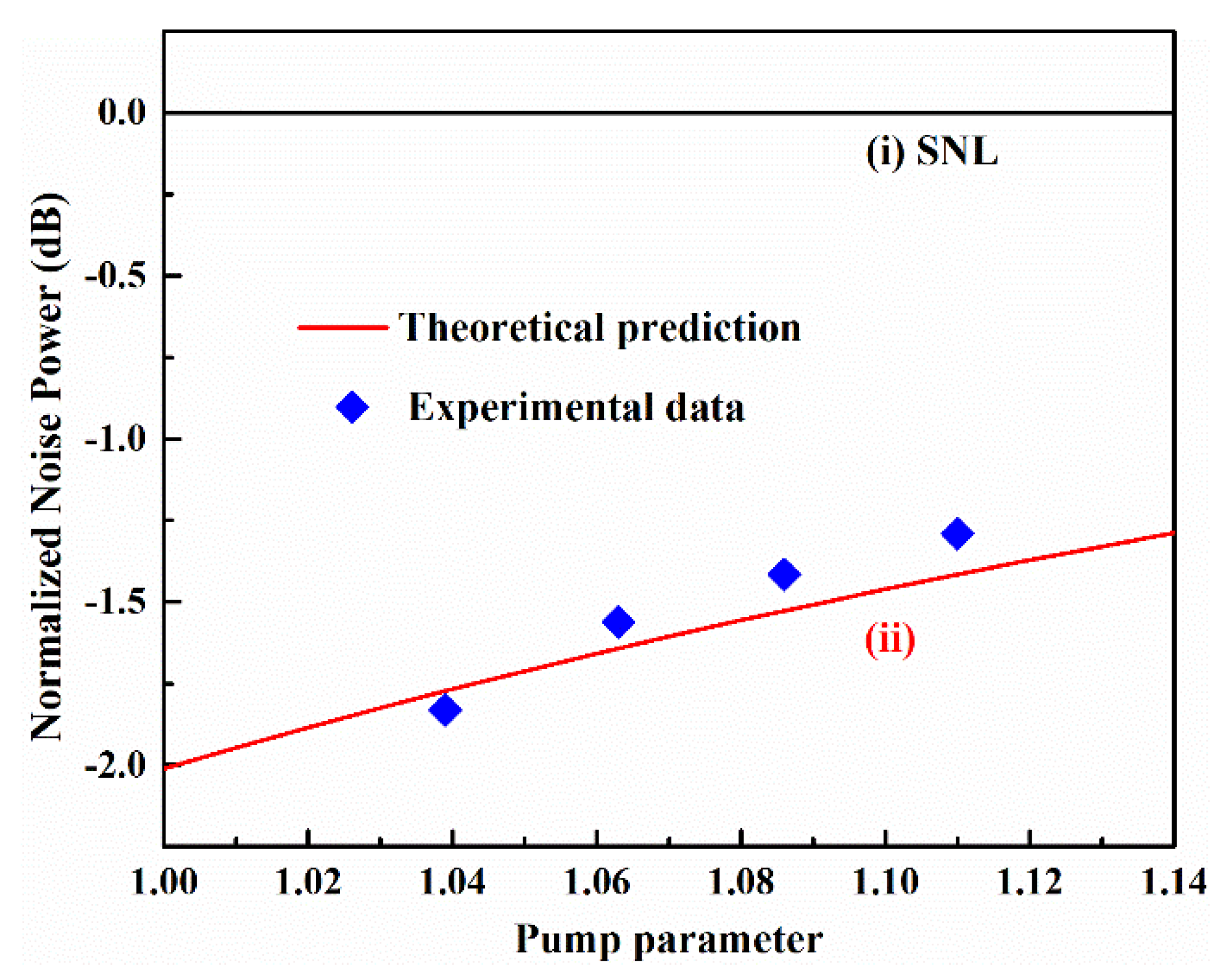
© 2020 by the authors. Licensee MDPI, Basel, Switzerland. This article is an open access article distributed under the terms and conditions of the Creative Commons Attribution (CC BY) license (http://creativecommons.org/licenses/by/4.0/).
Share and Cite
Nie, D.; Feng, J.; Li, Y.; Zhang, K. Two-Color Quantum Correlation between Down-Conversion Beams at 1.5 and 3.3 μm from a Singly Resonant Optical Parametric Oscillator. Appl. Sci. 2020, 10, 2698. https://doi.org/10.3390/app10082698
Nie D, Feng J, Li Y, Zhang K. Two-Color Quantum Correlation between Down-Conversion Beams at 1.5 and 3.3 μm from a Singly Resonant Optical Parametric Oscillator. Applied Sciences. 2020; 10(8):2698. https://doi.org/10.3390/app10082698
Chicago/Turabian StyleNie, Dandan, Jinxia Feng, Yuanji Li, and Kuanshou Zhang. 2020. "Two-Color Quantum Correlation between Down-Conversion Beams at 1.5 and 3.3 μm from a Singly Resonant Optical Parametric Oscillator" Applied Sciences 10, no. 8: 2698. https://doi.org/10.3390/app10082698
APA StyleNie, D., Feng, J., Li, Y., & Zhang, K. (2020). Two-Color Quantum Correlation between Down-Conversion Beams at 1.5 and 3.3 μm from a Singly Resonant Optical Parametric Oscillator. Applied Sciences, 10(8), 2698. https://doi.org/10.3390/app10082698



